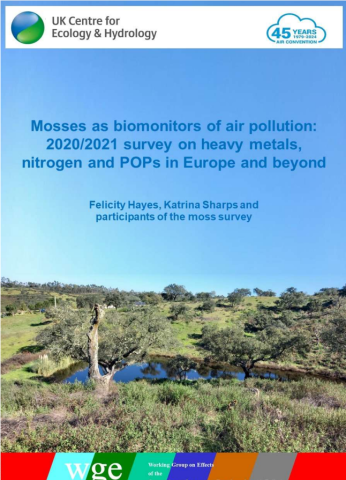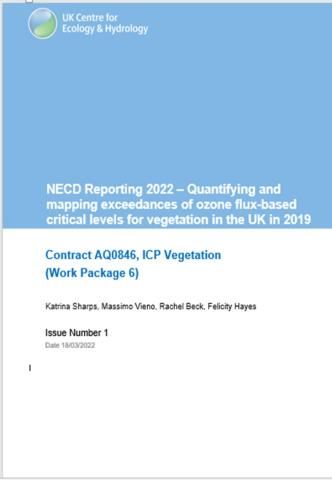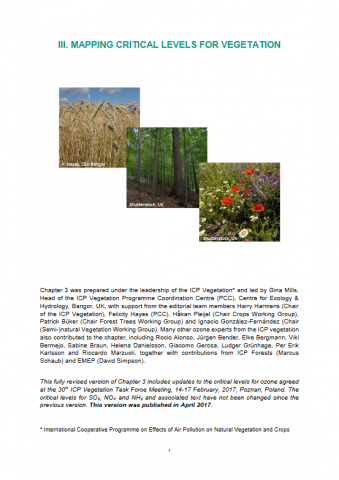Bibliography
Found 34 results
Author Title Type [ Year ]
] Filters: First Letter Of Last Name is A [Clear All Filters]
.
2007. Implications of climate change for the stomatal flux of ozone: A case study for winter wheat. Environmental Pollution. 146:763-770.
.
2007. Meta-analysis of the relative sensitivity of semi-natural vegetation species to ozone. Environmental Pollution. 146:754-762.
.
2007. Ozone risk assessment for agricultural crops in Europe: Further development of stomatal flux and flux-response relationships for European wheat and potato. Atmospheric Environment. 41:3022-3040.
.
2008. Challenges in understanding the risks to natural and semi-natural vegetation from ozone exposure. Italian Journal of Agronomy. 3:53-59.
.
2008. Impacts of nitrogen on vegetation.
.
2008. Metal accumulation in mosses across national boundaries: Uncovering and ranking causes of spatial variation. Environmental Pollution. 151:377-388.
.
2009. A comparison of North American and Asian exposure-response data for ozone effects on crop yields. Atmospheric Environment. 43:1945-1953.
.
2009. A comparison of North American and Asian exposure-response data for ozone effects on crop yields. Atmospheric Environment. 43:1945-1953.
.
2009. A comparison of North American and Asian exposure-response data for ozone effects on crop yields. Atmospheric Environment. 43:1945-1953.
.
2009. First thorough identification of factors associated with Cd, Hg and Pb concentrations in mosses sampled in the European Surveys 1990, 1995, 2000 and 2005. Journal of Atmospheric Chemistry. 63:109-124.
.
2009. First thorough identification of factors associated with Cd, Hg and Pb concentrations in mosses sampled in the European Surveys 1990, 1995, 2000 and 2005. Journal of Atmospheric Chemistry. 63:109-124.
.
2010. Are cadmium, lead and mercury concentrations in mosses across Europe primarily determined by atmospheric deposition of these metals? Journal of Soils and Sediments. 10:1572-1584.
.
2010. Are cadmium, lead and mercury concentrations in mosses across Europe primarily determined by atmospheric deposition of these metals? Journal of Soils and Sediments. 10:1572-1584.
.
2010. First Europe-wide correlation analysis identifying factors best explaining the total nitrogen concentration in mosses. Atmospheric Environment. 44:3485-3491.
.
2010. Mosses as biomonitors of atmospheric heavy metal deposition: Spatial patterns and temporal trends in Europe. Environmental Pollution. 158:3144-3156.
.
2010. Mosses as biomonitors of atmospheric heavy metal deposition: Spatial patterns and temporal trends in Europe. Environmental Pollution. 158:3144-3156.
.
2011. Nitrogen concentrations in mosses indicate the spatial distribution of atmospheric nitrogen deposition in Europe. Environmental Pollution. 159:2852-2860.
.
2011. Nitrogen concentrations in mosses indicate the spatial distribution of atmospheric nitrogen deposition in Europe. Environmental Pollution. 159:2852-2860.
.
2012. Country-specific correlations across Europe between modelled atmospheric cadmium and lead deposition and concentrations in mosses. Environmental Pollution. 166:1-9.
.
2012. Country-specific correlations across Europe between modelled atmospheric cadmium and lead deposition and concentrations in mosses. Environmental Pollution. 166:1-9.
.
2014. Ozone - the persistent menace: interactions with the N cycle and climate change. Current Opinion in Environmental Sustainability. 9-10:9-19.
.
2015. Heavy metal and nitrogen concentrations in mosses are declining across Europe whilst some "hotspots" remain in 2010. Environmental Pollution. 200:93-104.
.
2015. Heavy metal and nitrogen concentrations in mosses are declining across Europe whilst some "hotspots" remain in 2010. Environmental Pollution. 200:93-104.


